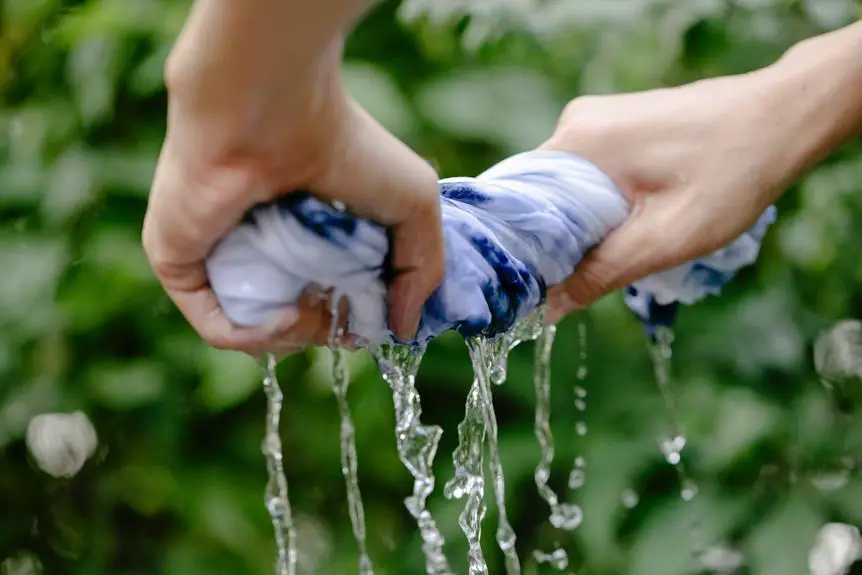Want to change the color of your green fabric? While it may seem tricky, dyeing green fabric a different color is entirely possible. By following the right techniques and using the appropriate dye, you can achieve the color you desire.
Understanding the dyeing process, selecting the correct dye, and properly preparing the fabric are crucial steps in achieving a successful color transformation. This guide will walk you through the process, from choosing the right dye to caring for your newly dyed fabric.
Key Takeaways
- Understanding the color wheel and dyeing techniques is important for achieving the desired outcome when dyeing green fabric.
- Choosing the right dye that is compatible with the fabric type and conducting colorfastness testing is crucial for long-lasting results.
- Preparing the fabric by pre-washing, using mordants if necessary, and removing existing color ensures optimal dye absorption.
- Following the dyeing process, including immersion duration and rinsing, and caring for the dyed fabric properly will help maintain the color vibrancy and prevent fading.
Understanding Green Fabric Dyeing
You can change the color of green fabric through dyeing using specific colorants and techniques. Green fabric dyeing involves understanding color theory and dyeing techniques to achieve the desired result.
Color theory is essential in determining the outcome of dyeing. By understanding the color wheel and the principles of mixing colors, you can effectively modify the green fabric to your preferred shade.
Dyeing techniques such as immersion dyeing, tie-dye, or dip dyeing offer different ways to manipulate the color of the fabric.
Fabric preparation is also crucial in green fabric dyeing. Pre-treating the fabric to remove any finishes or impurities ensures better dye absorption, resulting in a more vibrant and even color.
Understanding the properties of the fabric and the type of dye to be used is fundamental in achieving successful color transformation.
Choosing the Right Dye for Green Fabric
When dyeing green fabric a different color, it is crucial to select the right dye based on the fabric type and desired outcome. Choosing the right dye involves considering fabric color compatibility, dyeing techniques, and conducting colorfastness testing. Here's a table to help you understand the compatibility of different dyes with green fabric:
| Dye Type | Fabric Compatibility |
|---|---|
| Acid Dyes | Silk, Wool |
| Fiber Reactive | Cotton, Rayon |
| Direct Dyes | Cotton, Linen |
| Disperse Dyes | Polyester, Nylon |
Before selecting a dye, ensure it is compatible with the fabric you're dyeing. Additionally, consider the dyeing technique suitable for the fabric type. For example, fiber reactive dyes are ideal for cotton and rayon and require different application methods compared to acid dyes used for silk and wool. Lastly, perform colorfastness testing to ensure the dye will adhere well to the fabric and maintain its color over time. By carefully choosing the right dye and following appropriate dyeing techniques, you can successfully transform your green fabric into the desired color while achieving long-lasting results.
Preparing Green Fabric for Dyeing
Preparing green fabric for dyeing requires thorough cleaning to remove any dirt, oils, or finishes that may hinder the dye's ability to adhere to the fabric. Once the fabric is clean, you can proceed with the dyeing process. Here are four essential steps for preparing green fabric for dyeing:
- Fabric Pre-Wash: Before dyeing, pre-wash the green fabric with a mild detergent to remove any residual chemicals or finishes. This ensures that the fabric is clean and ready to absorb the new dye color evenly.
- Mordant Treatment: Consider treating the fabric with a mordant, such as alum, to improve color absorption. Mordants help the fabric to bond with the dye molecules, resulting in a more vibrant and long-lasting color.
- Color Removal: If the green fabric has an existing color, you may need to remove it before dyeing. Use a color remover specifically designed for fabrics to strip away the current color and prepare the fabric for the new dye.
- Testing: Before dyeing the entire piece of fabric, conduct a small test to ensure compatibility between the green fabric and the dye you intend to use. This helps in identifying any issues before committing to the full dyeing process.
Following these steps will help you prepare your green fabric for dyeing, ensuring optimal color absorption and a successful dyeing outcome.
Dyeing Process for Green Fabric
After completing the preparations, start dyeing your green fabric by immersing it in the dye solution and agitating it gently to ensure even color absorption.
When dyeing green fabric to a different color, achieving the desired shade involves understanding color mixing and dye absorption. The dye solution should be prepared according to the dye manufacturer's instructions. It's important to stir the dye solution thoroughly to ensure an even distribution of color.
Once the fabric is immersed in the dye solution, continue to agitate it gently to promote uniform color absorption. The duration of immersion varies based on the dye type and desired color intensity, so refer to the dye instructions for guidance.
After dyeing, rinse the fabric thoroughly to remove excess dye and allow it to dry according to the manufacturer's recommendations.
Keep in mind that achieving a different color on green fabric may require multiple dyeing sessions or the use of color-removing agents to lighten the green base before applying the desired color.
Caring for Dyed Green Fabric
To maintain the vibrancy and longevity of your dyed green fabric, proper care should be taken with consistent attention to washing and storage.
Here are four essential tips for caring for your dyed green fabric to prevent color fading and ensure its longevity:
- Cold Water Washing: When laundering dyed green fabric, use cold water and a gentle detergent to prevent color bleeding and fading. Avoid using bleach or harsh chemicals that can compromise the fabric's color vibrancy.
- Air Drying: Opt for air drying over machine drying whenever possible. Excessive heat from the dryer can cause the fabric's dye to fade more quickly. If using a dryer, set it to a low heat setting.
- Avoid Direct Sunlight: When storing dyed green fabric, keep it away from direct sunlight. Prolonged exposure to sunlight can cause the color to fade over time. Store the fabric in a cool, dark place to maintain its rich green hue.
- Gentle Handling: Handle dyed green fabric with care to prevent unnecessary wear and tear. Avoid rubbing or scrubbing vigorously when cleaning stains, as this can lead to color loss and fabric damage. Instead, opt for gentle spot cleaning techniques to preserve the fabric's vibrant color.
Frequently Asked Questions
Can Green Fabric Be Dyed a Lighter Color, Such as Pastel Shades?
Yes, green fabric can be dyed a lighter color, such as pastel shades. Color mixing and fabric painting techniques can be used to achieve the desired hue. It's important to follow proper dyeing procedures for best results.
Is It Possible to Dye Green Fabric With Natural Dyes, Such as From Plants or Vegetables?
Yes, you can dye green fabric with natural dyes extracted from plants or vegetables. By understanding color theory and utilizing eco-friendly fabric dye, sustainable fashion choices are achievable through natural dyeing methods.
What Types of Patterns or Designs Can Be Achieved When Dyeing Green Fabric?
When dyeing green fabric, various shades and intricate designs can be achieved. Utilize tie-dye techniques for vibrant patterns, ombre effects for a gradual color transition, and color mixing or fabric painting for personalized designs.
Can I Dye Green Fabric Without Using a Washing Machine or Sink?
You can dye green fabric without a washing machine or sink using various dyeing techniques. Eco-friendly dyes like natural plant dyes or low-impact dyes are great options. Consider methods like hand dyeing or tie-dye for vibrant results.
Are There Any Special Considerations for Dyeing Green Fabric That Has a Pattern or Print Already on It?
When dyeing green fabric with a pattern, consider the fabric's compatibility with the dye and the preservation of the pattern. To achieve color blending, employ appropriate dyeing techniques, such as low-water immersion or hand-painting methods.
- How Does Ring Spun Cotton Affect Garment Fit and Shape Retention? - August 13, 2024
- What Are the Challenges in Producing Ring Spun Cotton? - August 13, 2024
- Is Ring Spun Cotton Suitable for Plus-Size Clothing? - August 13, 2024





